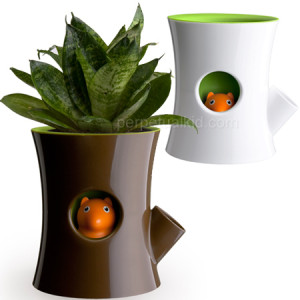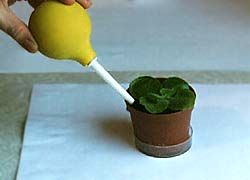Methods of watering African violets
 There are several methods of watering African violets, and the choice of one of them depends on several factors.
There are several methods of watering African violets, and the choice of one of them depends on several factors.
There are the following watering methods:
watering the plant from above;
watering the plant from below, in the plate;
immersion watering;
wick watering;
automated watering.
Watering the plant from above
– is a recommended method, but at the same time difficult to apply.
It is made with the help of a coat with an elongated and thin tip through which water is carefully poured on the edges of the pot, taking care that the soil from the overft does not erode. The water with which the plant will get wet should not fall on the leaves and in the center of the rosette (this can lead to rotting of the rosette and the death of African violet). Watering will stop when water appears on the plate, that will be thrown away.
- the wet one independently controls the wetting of the soil;
- from the soil layer on the surface of the pot, the harmful salts are eliminated.
Minuses:
- this method takes a long time;
- there is a risk of damaging the rosette of the plant;
- most of the time it is not possible to achieve uniform wetting of the soil. Water drains into the plate on the walls of the pot or from a few channels in the soil, most of the soil remaining dry.
To prevent excessive drying of the soil, the plant will sink into the water. The soil will saturate with water, and its capillary properties will be restored.
For the retention of harmful salts, above the ground in the pot will sprinkle sphangnum moss or porous pebbles, that will change regularly.
Watering the bottom plant, in the plate
– requires less time compared to the previous method.
One thing is important, in the plate will be poured as much water as the soil is able to absorb. Excess water will be eliminated after half an hour- an hour after watering, and the soil on the surface of the pot must be wet.
Regular application of the method in question leads to the 'coming to the surface' of the harmful salts. The layer of soil on the surface of the pot will change regularly.
The method of watering the bottom plant underwent over time a small change: between and under the pots with violets placed in plates is placed a carpet or a material that absorbs excess moisture and harmful salts and will change regularly.
Watering by immersion:
The pot with the plant is placed in a bulkier container filled with water so that the top edge of the pot remains on the surface. The pot is left in the container until the soil layer on the surface changes color (gets darker). The water penetrates through the drainage holes and fully saturates the soil, even if inside the pot there are dry portions of soil.
After, the pot is placed on a plate to remove excess water.
Advantages:
- complete saturation of the potted soil;
- an indispensable method in the urgent revival of dried plants;
- establishing an individual plant watering program.
Disadvantages:
- high complexity;
- if a common container for several plants is used, there is a probability that the plants will become contaminated with various pathogens;
- total air deprivation of the root system of the plant;
- significant fluctuations in soil moisture from watering to watering;
- harmful salts cannot be removed from the soil.
Watering by wick:
A fairly popular and fully justified method for those who have an impressive collection of African violets. The essence of this method is that in the water tank is placed a wick made of a synthetic material that easily absorbs water, the wick passes through the drainage holes of the giveci. The pot with violet is placed on the water tank, immersing the free end of the wick in water. By the action of capillary forces in the soil, water enters the soil through the wick, moistening it constantly and evenly.
Advantages and disadvantages of this method you can find HERE.
Automated watering:
There are plenty of automated irrigation systems – from the industrial ones to those for decorative plants in the rooms. These irrigation systems, drip is based on the distribution of water evenly and slowly, drop by drop, depending on the needs of the plant.
Due to the slow capillary movement of water in the soil, almost no air is removed from the soil due to water penetration. This allows the soil and roots of the plants to breathe properly throughout the growing season.
[.flv:http:youtube.com/watch?v=9S0XPgf490Y 560 349]
Advantages:
- uniform soil moisture,
- watering with controlled amounts of water;
- distribution in the area of plant root development,
- excludes the involvement of the florist in the irrigation process,
- salts from the water do not accumulate in the soil,
- fertilization of the plant simultaneously with its watering,
- insecticides applied with this system have a longer time of action, reducing the number of applied treatments,
- the layer on the surface of the pot is permanently washed.
It is important to take care that the Parma violets are not immersed in the water retained in the plates. Pots with plants will be placed on special supports and the water flow will be adjusted accordingly with the needs of the plant.
The disadvantages of such irrigation systems are:
- high cost;
- difficulty purchasing;
- the possibility of damage to these systems during watering.
- some embarrassment in their handling.



How many cm of wick is left inside the pot ?
I put some violets on the wick and I find the substrate too wet (Florimo earth for acidophilic 50% + perlite 50% )
The wick is made of 8mm tights.
I suspect there's too much fuse inside the pot or it's too high put. Thanks in advance for the reply.
The length of the wick should be 20-25 cm, width of 7-8 mm, 8-10 cm of the wick is left outside the pot. The wick is held by hand and covered with pearlite or earth mixture 1.5-2 cm, then it sits above the ground in the shape of a ring.
If in the pot you planted an African violet reached maturity, the pot will be filled with solin proportion of 2-3 of its height, if you planted a chicken violet, the pot is filled with soil.
More information can be found in this article: The wick watering system